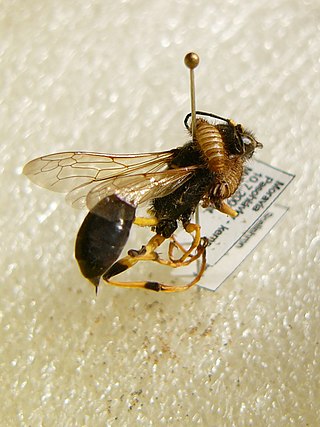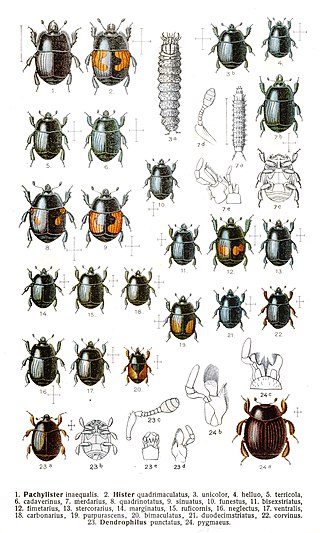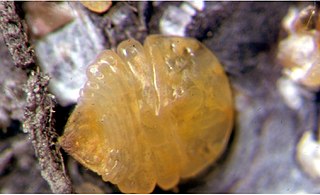
A pest is any organism harmful to humans or human concerns. The term is particularly used for creatures that damage crops, livestock, and forestry or cause a nuisance to people, especially in their homes. Humans have modified the environment for their own purposes and are intolerant of other creatures occupying the same space when their activities impact adversely on human objectives. Thus, an elephant is unobjectionable in its natural habitat but a pest when it tramples crops.

Scale insects are small insects of the order Hemiptera, suborder Sternorrhyncha. Of dramatically variable appearance and extreme sexual dimorphism, they comprise the infraorder Coccomorpha which is considered a more convenient grouping than the superfamily Coccoidea due to taxonomic uncertainties. Adult females typically have soft bodies and no limbs, and are concealed underneath domed scales, extruding quantities of wax for protection. Some species are hermaphroditic, with a combined ovotestis instead of separate ovaries and testes. Males, in the species where they occur, have legs and sometimes wings, and resemble small flies. Scale insects are herbivores, piercing plant tissues with their mouthparts and remaining in one place, feeding on sap. The excess fluid they imbibe is secreted as honeydew on which sooty mold tends to grow. The insects often have a mutualistic relationship with ants, which feed on the honeydew and protect them from predators. There are about 8,000 described species.

Histeridae is a family of beetles commonly known as clown beetles or hister beetles. This very diverse group of beetles contains 3,900 species found worldwide. They can be easily identified by their shortened elytra that leaves two of the seven tergites exposed, and their geniculate (elbowed) antennae with clubbed ends. These predatory feeders are most active at night and will fake death if they feel threatened. This family of beetles will occupy almost any kind of niche throughout the world. Hister beetles have proved useful during forensic investigations to help in time of death estimation. Also, certain species are used in the control of livestock pests that infest dung and to control houseflies. Because they are predacious and will even eat other hister beetles, they must be isolated when collected.

In trees, heart rot is a fungal disease that causes the decay of wood at the center of the trunk and branches. Fungi enter the tree through wounds in the bark and decay the heartwood. The diseased heartwood softens, making trees structurally weaker and prone to breakage. Heart rot is a major factor in the economics of logging and the natural growth dynamic of many older forests. Heart rot is prevalent throughout the world affecting all hardwood trees and can be very difficult to prevent. A good indication of heart rot is the presence of mushrooms or fungus conks on the tree.

Lepidosaphes ulmi also known as apple mussel scale or oystershell scale is a widely invasive scale insect that is a pest of trees and woody plants. The small insects attach themselves to bark and cause injury by sucking the tree's sap; this metabolic drain on the plant may kill a branch or the entire tree.

Aonidiella aurantii or red scale is an armored scale insect and a major pest of citrus. It is thought to be a native of South China but has been widely dispersed by the agency of man through the movement of infected plant material. In the United States it is known as California red scale. It was first found in California between 1868 and 1875, apparently brought there on planting material imported from Australia.

Icerya purchasi is a scale insect that feeds on more than 80 families of woody plants, most notably on Citrus and Pittosporum. Originally described in 1878 from specimens collected in New Zealand as pests of kangaroo acacia and named by W.M. Maskell "after the Rev. Dr. Purchas who, [he] believe[d], first found it", it is now found worldwide where citrus crops are grown. The cottony cushion scale originates from Australia.

Diaspididae is the largest family of scale insects with over 2650 described species in around 400 genera. As with all scale insects, the female produces a waxy protective scale beneath which it feeds on its host plant. Diaspidid scales are far more substantial than those of most other families, incorporating the exuviae from the first two nymphal instars and sometimes faecal matter and fragments of the host plant. These can be complex and extremely waterproof structures rather resembling a suit of armor. For this reason these insects are commonly referred to as armored scale insects. As it is so robust and firmly attached to the host plant, the scale often persists long after the insect has died.
A bottle trap is a type of baited arboreal insect trap for collecting either prized or harmful frugivorous beetles, especially flower beetles, leaf chafers and longhorn beetles as well as wasps and other unwanted flying insects.

Cryptococcus fagisuga, commonly known as the beech scale or woolly beech scale, is a felted scale insect in the superfamily Coccoidea that infests beech trees of the genus Fagus. It is associated with the transmission of beech bark disease because the puncture holes it makes in the bark allow entry of pathogenic fungi which have been identified as Nectria coccinea var. faginata and sometimes Nectria galligena.

Eriococcidae is a family of scale insects in the order Hemiptera. They are commonly known as felt scales or eriococcids. As of 2023, there are 109 genera and 681 species. Each species is usually specific to a different plant host, or closely related group of hosts.

Aulacaspis yasumatsui, or cycad aulacaspis scale (CAS), is a scale insect species in the genus Aulacaspis that feeds on cycad species such as Cycas revoluta or Dioon purpusii. Other common names include the cycad scale, the sago palm scale, and the Asian cycad scale. This is a serious pest of cycads which can kill its host plant.
Anaphes nitens is a species of fairyfly, a chalcid wasp in the family Mymaridae. Native to Australia, it is an egg parasitoid of the gum tree snout beetle, a pest of Eucalyptus trees, and has been used in biological pest control of that species.

Aonidiella orientalis is a species of insect in the family Diaspididae, the armored scale insects. It is known commonly as the Oriental yellow scale. It is an agricultural pest on a wide variety of crop plants.

Pulvinaria regalis is a species of scale insect in the family Coccidae. Although it is commonly known as the horse chestnut scale, it affects other trees besides horse chestnuts as well as many species of woody shrubs. Adults are normally all female and produce eggs by parthenogenesis. The insects are thought to have originated in Asia but arrived in Europe in the second half of the twentieth century.
Aonidiella citrina or yellow scale is an armored scale insect from the family Diaspididae. It feeds by sucking sap from plants in a number of plant families, but is mostly known for being a pest of citrus.
Hemiberlesia lataniae, the latania or palm scale, is a species of armored scale insect in the family Diaspididae. It was first described by the French entomologist Victor Antoine Signoret in 1869 using Latania lontaroides, a species of palm tree endemic to Réunion as its host; since then, it has been found on avocado trees growing in South Africa, Australia, Israel, the United States, and on a range of other plants in many parts of the world.

Quadraspidiotus juglansregiae, commonly known as the walnut scale, is a species of armoured scale insect in the family Diaspididae. It is native to North America where it feeds on a wide range of ornamental and forest trees and bushes.
Selenaspidus articulatus is an armoured scale insect in the family Diaspididae, commonly known as the West Indian red scale. It is a polyphagous species found in tropical and subtropical regions around the world as a pest species of Citrus and other fruit and ornamental trees.
Parlatoria blanchardi, the date palm scale, is a species of armored scale insect in the family Diaspididae. It is a widespread and serious pest of palms, both date palms and ornamental species.














